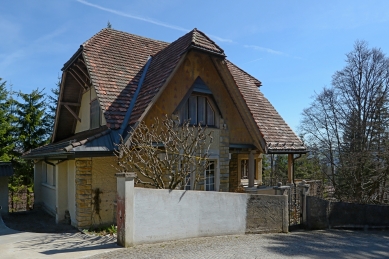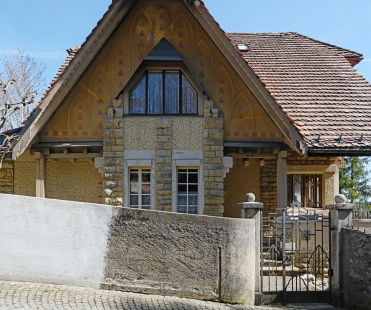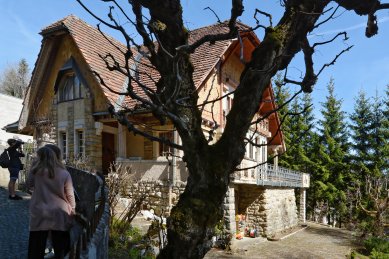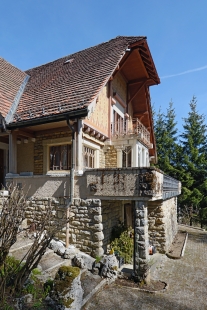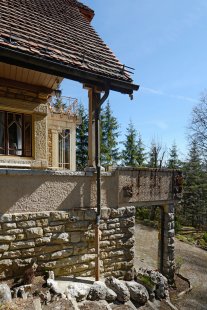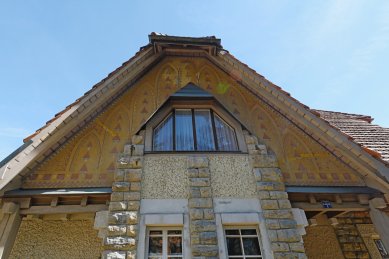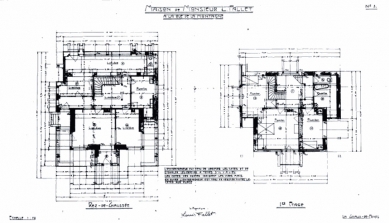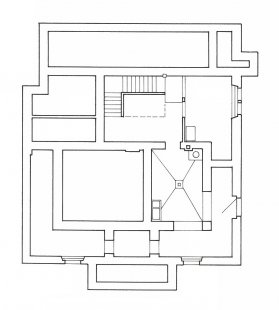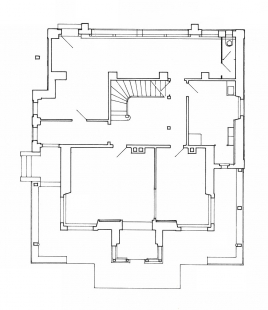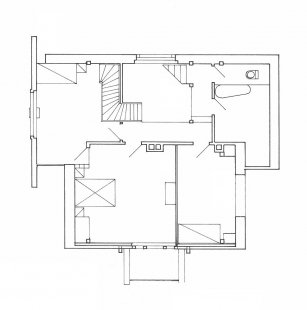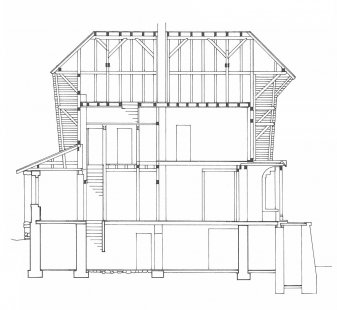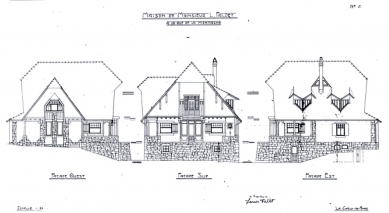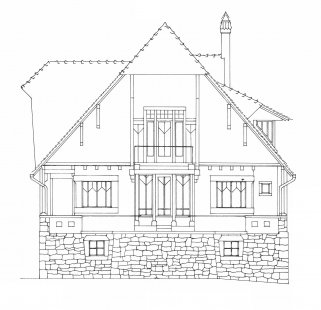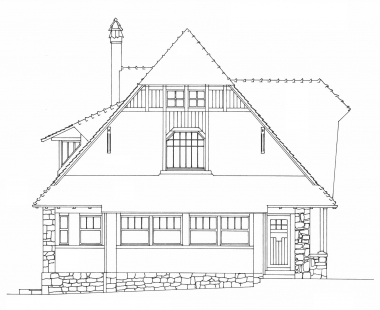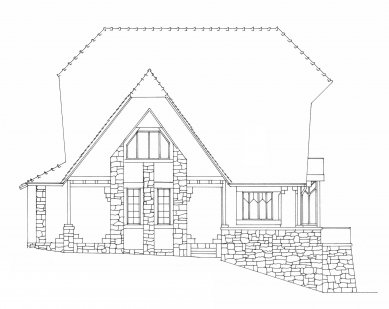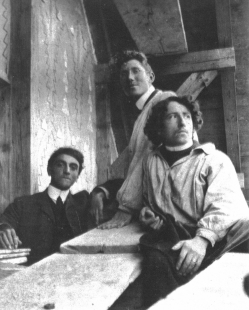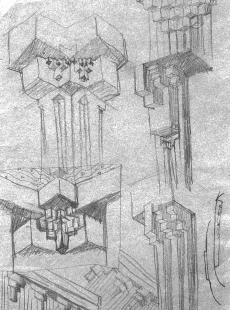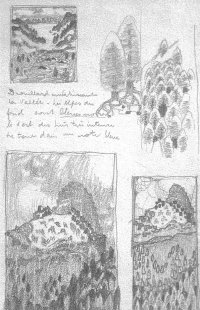
Vila Fallet

The Villa for the engraver Louis Fallet was Jeanneret's first realization, which he designed while still a high school student in collaboration with local architect René Chapallaz. Louis Fallet was a jewelry designer, published scholarly articles, and served on the examination board at the École des Arts Décoratifs. In 1904, he was a member of the jury for the Revue internationale de l'Horologerie, which awarded seventeen-year-old Jeanneret second place. Here, Fallet noticed Jeanneret's talent and boldly entrusted him with the realization of his own house. A significant role in this was played by Charles L'Eplattenier, another member of the faculty at the art school in La Chaux-de-Fonds, who guided his students toward knowledge through direct experience, allowing a group of inexperienced high school students without construction knowledge to engage in the real realization of a house. The work on the construction was part of the practical teaching at the school, where students could also try to implement the proposed decoration directly. The design work was entrusted to architect René Chapallaz, who was a friend of L'Eplattenier. L'Eplattenier's own house from 1902 is located across the street from Fallet’s house. Both Jeanneret and Chapallaz worked on the house for free. Only the draftsmen in Chapallaz’s studio were paid. However, Chapallaz's name does not appear on any of the drawings.
The mountain cottage with a massive stone base and steep roof derives from regional customs. At that time, the young Jeanneret, under the theoretical influence of L'Eplattenier, sought his own style that would both reflect local specifics and follow the emerging Art Nouveau movement.
Europe at the time was looking to England towards Morris's "Arts and Crafts" movement, which opposed the excessive use of curves and returned to the craft tradition. In our region, at the turn of the last century, this movement was best represented by Dušan Jurkovič, whose work newly interpreted Slavic traditions. For Jeanneret’s work from this period, the term “Sapin style” (pine style) has since been coined, referring to simplified decoration based on surrounding forests, projected into the structural solutions of stone and wooden joints, details of railings, window frames, and the color of wall paintings.
The house rests on a vaulted stone pedestal. The ground floor features the living area, while the upper floor contains bedrooms, and the highest level is the attic. The south-facing living space on the ground floor ends with a glassed-in bay window that further connects to a large terrace. The entrance hall opens up two stories. Diffused daylight comes here from the upper floor through a north-facing window. The broken staircase serves as the central motif of the hall.
Fallet’s house was received so favorably that it enabled Jeanneret to realize two more mountain cottages on the wooded hill of Pouillerel in the following years. The other clients were Fallet’s son-in-law Ulysses Jules Jaquemet and the second was Albert Stotzer, who also married into the Fallet family. The last villa in this area was built by Jeanneret for his parents in a different neoclassical style.
In later letters to teacher L'Eplattenier, Le Corbusier compared the early period to “lost youth,” where under the influence of Arts and Crafts he contributed to the deterioration of provincial taste, which was then an understandable stance for a proponent of modernism, but upon closer examination of the Fallet villa, it is evident that even then the young Jeanneret was gifted with the talent for geometric abstraction and the ability to transform basic natural principles into strong architectural forms, which accompanied him throughout his life.
Louis-Edouard Fallet moved into the villa after a fourteen-month construction period on August 9, 1907, and left it on June 9, 1921. However, he lived in La Chaux-de-Fonds until his death in September 1956. The house is still inhabited and privately owned today.
The mountain cottage with a massive stone base and steep roof derives from regional customs. At that time, the young Jeanneret, under the theoretical influence of L'Eplattenier, sought his own style that would both reflect local specifics and follow the emerging Art Nouveau movement.
Europe at the time was looking to England towards Morris's "Arts and Crafts" movement, which opposed the excessive use of curves and returned to the craft tradition. In our region, at the turn of the last century, this movement was best represented by Dušan Jurkovič, whose work newly interpreted Slavic traditions. For Jeanneret’s work from this period, the term “Sapin style” (pine style) has since been coined, referring to simplified decoration based on surrounding forests, projected into the structural solutions of stone and wooden joints, details of railings, window frames, and the color of wall paintings.
The house rests on a vaulted stone pedestal. The ground floor features the living area, while the upper floor contains bedrooms, and the highest level is the attic. The south-facing living space on the ground floor ends with a glassed-in bay window that further connects to a large terrace. The entrance hall opens up two stories. Diffused daylight comes here from the upper floor through a north-facing window. The broken staircase serves as the central motif of the hall.
Fallet’s house was received so favorably that it enabled Jeanneret to realize two more mountain cottages on the wooded hill of Pouillerel in the following years. The other clients were Fallet’s son-in-law Ulysses Jules Jaquemet and the second was Albert Stotzer, who also married into the Fallet family. The last villa in this area was built by Jeanneret for his parents in a different neoclassical style.
In later letters to teacher L'Eplattenier, Le Corbusier compared the early period to “lost youth,” where under the influence of Arts and Crafts he contributed to the deterioration of provincial taste, which was then an understandable stance for a proponent of modernism, but upon closer examination of the Fallet villa, it is evident that even then the young Jeanneret was gifted with the talent for geometric abstraction and the ability to transform basic natural principles into strong architectural forms, which accompanied him throughout his life.
Louis-Edouard Fallet moved into the villa after a fourteen-month construction period on August 9, 1907, and left it on June 9, 1921. However, he lived in La Chaux-de-Fonds until his death in September 1956. The house is still inhabited and privately owned today.
The English translation is powered by AI tool. Switch to Czech to view the original text source.
0 comments
add comment


